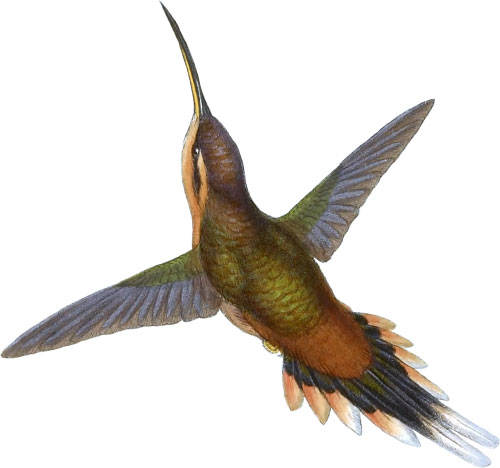Belted Hermit
The forests bordering the upper part of the River Amazon
No group of birds requires greater care in discriminating its various members than the little Phaëthorni, of which there are evidently several very distinct species, but which, from their minute size and their very great similarity of colour, it is most difficult to distinguish the one from the other.
These various species are distributed over the wide area extending from Mexico to Peru on the western, and from the Brazils to the Caraccas on the eastern part of the great continent of America. Diminutive as they all are, the present species may be regarded as the very smallest of the group. I have long had a female specimen of this little bird in my possession, sent from the neighbourhood of the Rio Negro by Mr. Wallace, but deferred describing it until I had seen the male: this sex is, I believe, at length before me, having been sent by Mr. Lawrence of New York as the type of his Phaëthornis nigricinctus. Both Mr. Lawrence’s specimens and my own have very lengthened bills, with the yellow colouring of the under mandible extending almost to the end, in which respect ‘they differ from all the other members of the genus, and especially from the species I have named P. Episcopus, but to which they are otherwise most nearly allied. Mr. Lawrence’s specimen was collected by Mr. Moore while descending one of the tributaries of the Amazon from Quito to Para: we may therefore infer that the little-known countries of the Upper Amazon are its true habitat.
The male has the upper surface bright bronzy green, browner on the head; upper tail-coverts bright ferruginous; tail bronzed coppery brown, the outer margin of the external feathers, the tips of the two central feathers and the two next pairs on each side greyish white; wings purplish brown; under surface deep rufous, with a broad purplish-black band across the breast; ear-coverts black; above the eye a line of rufous; upper mandible black; lower mandible orange-red, becoming paler towards the extreme end.
The female is coppery bronze above; has the tail-feathers of a more lengthened and cuneate form and largely tipped with buff; the whole of the under surface rich buff; under mandible, with the exception of the extreme tip, yellow.
 Phaëthornis Longuemareus
Longuemare’s Hermit
Phaëthornis Longuemareus
Longuemare’s Hermit
 Phaëthornis Amaura
Amaura Hermit
Phaëthornis Amaura
Amaura Hermit
 Phaëthornis viridicaudata
Green-tailed Hermit
Phaëthornis viridicaudata
Green-tailed Hermit
 Paëthornis zonura
Southern Hermit
Paëthornis zonura
Southern Hermit
 Phaëthornis Adolphi
Adolph’s Hermit
Phaëthornis Adolphi
Adolph’s Hermit
 Phæthornis griseogularis
Grey-throated Hermit
Phæthornis griseogularis
Grey-throated Hermit
 Phaëthornis striigularis
Stripe-throated Hermit
Phaëthornis striigularis
Stripe-throated Hermit
 Phaëthornis obscura
Obscure Hermit
Phaëthornis obscura
Obscure Hermit
 Phaëthornis Episcopus
Bishop Hermit
Phaëthornis Episcopus
Bishop Hermit
 Phaëthornis Eremita
Little Hermit
Phaëthornis Eremita
Little Hermit
 Phaëthornis pygmæus
Pigmy Hermit
Phaëthornis pygmæus
Pigmy Hermit
Featuring all 422 illustrated species from John Gould’s A Monograph of the Trochilidæ, or Family of Humming-Birds arranged by color.